 |
 |
 |
A Vanished Landscape
To Have and
Have Not
For the greater part of
its existence Liverpool was clustered around the river Mersey, with the township
spreading little further 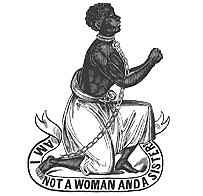 than a mile or so inland.
The 18th century heralded a massive boom in shipping and a subsequent
dock-building program which was unequalled anywhere in the world. It was an era of great wealth for the shipping industry in Liverpool albeit
built upon the back of the Slave Trade and the Triangle of ; cotton from America
to Liverpool, pottery and household goods from Liverpool to Africa and most
valuable of all, slaves from Africa to America and the West Indies. Even during the years
when it became the foremost port in the land and forests of masts were thick on
the waterfront, the ship-owners, sea-captains and seafarers and anyone
associated with the docks wanted and needed to be in close proximity to their
than a mile or so inland.
The 18th century heralded a massive boom in shipping and a subsequent
dock-building program which was unequalled anywhere in the world. It was an era of great wealth for the shipping industry in Liverpool albeit
built upon the back of the Slave Trade and the Triangle of ; cotton from America
to Liverpool, pottery and household goods from Liverpool to Africa and most
valuable of all, slaves from Africa to America and the West Indies. Even during the years
when it became the foremost port in the land and forests of masts were thick on
the waterfront, the ship-owners, sea-captains and seafarers and anyone
associated with the docks wanted and needed to be in close proximity to their work place and consequently never strayed far from the seafront. Gambier Terrace, Duke St,
Canning St, Rodney St and many other still grand houses of the era were
built upon the wealth engendered by the shipping trade and in particular from
the transport of slaves across the Atlantic. The Slave Trade was abolished in England in 1806,
followed by riots in the city from merchants afraid for their trade, but
Liverpool ships flourished more than ever as they found alternative cargoes and
the transatlantic passenger trade burgeoned. As land for the prestigious
housing near to the docks became less, it became fashionable to live around the
perimeter of parks and open spaces and Newsham Park, Sefton, Park, Stanley Park
and others became surrounded by mansions while the more wealthy ship-owners
moved into vast estates such as the McIver brothers in Calderstones and the
Holt family in Sudley.
work place and consequently never strayed far from the seafront. Gambier Terrace, Duke St,
Canning St, Rodney St and many other still grand houses of the era were
built upon the wealth engendered by the shipping trade and in particular from
the transport of slaves across the Atlantic. The Slave Trade was abolished in England in 1806,
followed by riots in the city from merchants afraid for their trade, but
Liverpool ships flourished more than ever as they found alternative cargoes and
the transatlantic passenger trade burgeoned. As land for the prestigious
housing near to the docks became less, it became fashionable to live around the
perimeter of parks and open spaces and Newsham Park, Sefton, Park, Stanley Park
and others became surrounded by mansions while the more wealthy ship-owners
moved into vast estates such as the McIver brothers in Calderstones and the
Holt family in Sudley.
But not everybody in the
city owned a ship and not everybody lived in a Gambier Terrace----there were a
great many who earned very little at all and they were a very large proportion
of the population. They were an underclass who were totally subservient to
and reliant upon their wealthier masters, living in dire poverty and suffering
from diseases now only found in Third W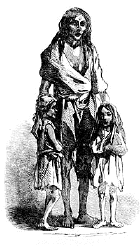 orld countries. There was no safety
net for those who fell into debt and the workhouse awaited those who did ---the
very name of which filled even the bravest with dread. Ironically, the
Liverpool workhouse was situated upon the site of the present Metropolitan Cathedral on
Brownlow Hill and it speaks volumes about the city at that time that it was the
largest of its kind in the country. Until recently, some of the workhouse
buil
orld countries. There was no safety
net for those who fell into debt and the workhouse awaited those who did ---the
very name of which filled even the bravest with dread. Ironically, the
Liverpool workhouse was situated upon the site of the present Metropolitan Cathedral on
Brownlow Hill and it speaks volumes about the city at that time that it was the
largest of its kind in the country. Until recently, some of the workhouse
buil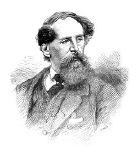 dings were used as offices by the Cathedral staff and the workhouse bell is
among the Cathedral belfry carillon.
dings were used as offices by the Cathedral staff and the workhouse bell is
among the Cathedral belfry carillon.
The great days of Liverpool ships are legendary throughout the world but the
city itself was also home to grinding poverty and all the things that go with it
for much of the population. Disease, crime and venality were common ---it
was the time of Maggie May and Paradise St and was famous with sailors all over
the world telling lurid tales of its grog-shops and sex trade. Charles
Dickens noticed many of these things on his frequent visits to give readings
from his works in St. Georges Hall. He based his novel 'The Uncommercial
Traveller' on his experiences of Liverpool and the adventures of his hero
Poor Jack are set to a background of Liverpool's poorer quarters.
Court Appearance
The population of Liverpool had swelled in proportion to its wealth and from the
early years of the 19th century there was a need for more and more houses.
Speculators were not slow to see the opportunities and set about building cheap
housing for the masses. There was nothing humanitarian about their projects ---
the homes were designed with but one specification which was to accommodate as
many people as possible in order to accrue as much rent as possible -----and the
simple design did just that.
The design of a typical block was of two rows of terraced houses, back-to-back,
each sharing a common dividing wall which ran like a spine down the centre of
the building. Each side of the dividing wall consisted of a cellar dwelling and
three stories above ground level----- each of the three stories containing a
single room with the source of light and air coming from the front elevation of
each.
The buildings were nothing more than the human version of a pigeon-loft and
their construction was a monument to the greed and inhumanity of those who
designed and built them. Adding insult to injury, the rents were so
high that in many cases several or more families were forced to join forces to
occupy a single room in order to share the rent.
Sanitation was almost non-existent and the communal latrine was emptied on a
"need-to-do" basis so that when it was overflowing, a number of
men called "scavengers" had the unenviable job of a drainingthe whole
putrid mess and removing it until next time. It is an indication of just
how far we have come in such a relatively short time that in many parts of
India, the same system is still in use.
The cellar dwellings were literally the lowest of the low and were reliably
described by no less an authority than Dr Duncan as ;
"Being
10 to 12 feet square, sometimes flagged but more often than not with an earthen
floor, windowless and with no source of light or air but a door standing lower
than street level."
Washing facilities were also lacking and if they existed at all it were situated within
the confines of a communal courtyard along with a single source of cold
water. In the more luxurious yards there was a communal washing area
consisting of a stone-bench. A municipal rubbish removal scheme was
non-existent.
These places were called 'courts' and as noxious as they were in their
conception their notoriety was to increase further after 1840. The Irish
Famine saw unprecedented numbers of Irish immigrants arriving in Liverpool with
the intention of traveling to America but many of them were unable to afford the
fair and others were fleeced out of what little money they had.
Inevitably, a great proportion of the immigrants found themselves becoming a
part of life in the courts swelling the numbers to insupportable numbers
of seething humanity.
Even Dickens would have found it beyond his descriptive powers to tell of
life in a Liverpool court, circa 1840, and the residents would have been excused
for believing that Compassion, Philanthropy and Humanity had taken a long
holiday but there were caring people working behind the scenes and they are the
true heroes and heroines of the city.
Court
Proceedings
Nothing can illustrate more
emphatically just how far we have come along the road in the matter of Public
Health than the complete inability of the Victorians to identify the causes of
the diseases afflicting the people living in the courts. They knew that
there were outbreaks of Cholera, they recognized Typhus and they all too often
saw Tuberculosis; they knew there was no sanitation, they knew there was
overcrowding and they knew there was no sewerage ----and yet inexplicably they
they never associated one with the other. The nearest they got to an
answer was an idea which gained general recognition from 1840 onwards called the
Miasma Theory which stated that "bad air" from rotting vegetation was
the source of the problem. As vague as this was, it did have a tenuous
grasp on the fact that hygiene was the root cause of the ills afflicting the
courts and it did lead eventually to dealing with these basic tenets of living
although the wheels ground exceedingly slowly.
Although the denizens of the reeking courts didn't know it there were heroes and
heroines even in those dark corners of the earth working to improve their
dreadful lot in life. Sadly, most of their work would not come to fruition
until well into the next century and there were many who lived their whole lives
in poverty and degradation in mid-Victorian Liverpool while others made small
fortunes.
It was standard procedure in hospitals run by Florence Nightingale that they
should be scrupulously clean and she saved many lives during the Crimean War {
1850,s} in her hospital at Scutari merely by applying this simple formula.
It is illustrative of the ignorance as to the value of hygiene at that time,
when even her nurses thought she was just obsessive. Florence Nightingale
later lectured in Liverpool and worked with Rathbone in health matters
throughout the city.
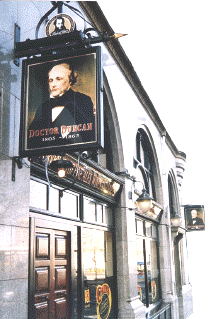
Dr. William Henry Duncan was born in Seel St in 1805 -----his former home is The
Blue Angel nightclub. He graduated as Dr. of Medicine in 1829 at Edinburgh
and returned to Liverpool where his work as a General Practitioner took him into
the poorest quarters of the city. He quickly came to realize that it was
no coincidence that the greater part of his patients lived in slum conditions
and until those conditions altered then his efforts were negligible. The
authorities at the time held the ludicrous theory which equated the health
of the city to the wealth of the city and as that was booming then all was
well. It was Duncan's great achievement to draw the authorities attention
to the plight of the thousands of slum dwellers which was accomplished with the
use of pamphlets and lectures. He also warned of the epidemics which were
bound to arise. His efforts and those of other like-minded philanthropists
in the city led to action in Parliament, resulting in Duncan's appointment as
the first Medical Officer of Health in the country in 1846 ---- a massive task
which would occupy him for the rest of his life.
At
the time of Duncan's appointment, the number of Irish immigrants was increasing
daily and a conservative estimate placed a number of 80,000 remaining in the
city, most of them crammed into the courts. There were several occasions
when no less than 40 people were found to be inhabiting one of the cellar rooms
previously mentioned. Three years later and Duncan's forecast of an
epidemic came true with an outbreak of Asiatic cholera in 1849. Hundreds
died daily and although it was no consolation to Duncan to be proven right the
outbreak triggered the beginning of he end of life in the courts and drew the
attention of the authorities as nothing else could to the plight of the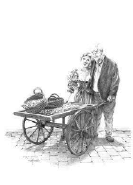 people
living in them. Although they were still working on the basis of the Miasma
Theory the authorities at last began to draw up some basic plans for rubbish
removal and sanitation.
people
living in them. Although they were still working on the basis of the Miasma
Theory the authorities at last began to draw up some basic plans for rubbish
removal and sanitation.
Good hygiene was the
thread which ran through all of the reformers proposals and very often they were
so simple that they would seem to be of little consequence. One of the
most basic ideas was the introduction of the wash-house in which Kitty Wilkinson
was the instigator and prime-mover. So simple and yet so effective, a
place where each community could wash their clothes in the luxury of hot water
and Kitty was astute enough to provide warm rest-rooms and a meeting place for
women whose lives were nothing but unremitting toil. The wash-houses
spread throughout the city and it is impossible to estimate how many lives they
saved nor how much they eased the work-load of the women who used them.
The value of the wash-house can never be underestimated and it is an indication
of their worth that they were still in use in the 1950's, as my mother could
have testified. The wash-houses were an improvement without any shadow of
a doubt but in terms of lightening a woman's work-load, relative to today's
appliances it was still hard labour to push a week's washing in a pram to the
nearest wash-house and then push it back again and let's not forget that the
clothes still remained to be ironed with a solid-cast iron heated on the fire.
Kitty Wilkinson had come to Liverpool from Ireland in 1812 as an immigrant.
Although the above philanthropists worked effectively within their sphere, the
real answer was the removal of the source of all ills, the courts
themselves. This was accomplished in the fullness of time but within that
time-span a whole generation lived in a squalor unimaginable today. The
last court in the city can be found in Duke St and in a final irony it has been
converted into luxury apartments.
Out of Court
Settlement
The Victorian idyll of Edge Hill and Kensington with virtually their own park
was further increased in 1830 by the exciting prospect of the first passenger
railway station the world had ever seen. Stephenson's Rocket won the right
to be the chosen locomotive by winning the Rainhill Trials and work was well
underway for a goods and passenger line from Liverpool to Manchester.
Following the success of the line, another line was chiselled out of the solid
sandstone to Crown St and to Lime St.
The engineering feats were nothing
short of magnificent and made even more so by the use of techniques and
equipment that would not have been unfamiliar to the Ancient Egyptians.
The tunnels and arches still stand today and are a testament to Victorian
energy and values.
Engravings of the time show appreciative crowds,
dangerously close to the action, applauding the skills of everyone
involved. They are without exception, middle to upper-class ladies and
gentlemen.
When the crenellated towers of the new reservoir appeared in 1854, complementing
the brand-new Kensington Library the bourgoursie in their Victorian idyll would
have been excused for thinking that a benevolent city council was showering them
with gifts to further enhance their gilded lives and they would have probably
been correct. However, there would have been very few who could have
foreseen the ramifications of the brand new Gas Works which went up in 1854 or
the massive changes that it presaged. From that time onwards, terraced
houses spreading outwards from the city centre would slowly but surely engulf
Victorian Edge Hill and by 1885 they would surround it on all sides in a sea
of back-to-back terraced houses. Edge
Hill was a finished work by 1885.
For the first time ever, from
the 1850's onwards the city expanded outwards into the surrounding
countryside and has been expanding ever since. The pressure from the
seething city centre had finally become intolerable and a creeping tide of new
housing spread in a huge circle outwards taking in villages, hamlets and
countryside as never before and eventually washing up on the shores of suburbia.
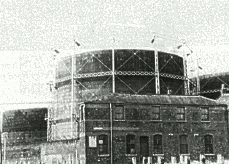
In a world where life was a
daily struggle there were few who knew or cared about The Rainhill Trials,
Stephenson's Rocket or Edge Hill Station, but the Railway was to become
fundamental to those court-dwellers who moved into this area and the Gas Works
perhaps more so. The Gas Works at night was not a mill but it was
certainly "dark and satanic" spewing out a lethal cocktail of coke
fumes night and day which local residents came to think of as the main
constituent of he planet's atmosphere and soothed their throats with Woodbines
or Capstan Full Strength. Along with the fumes from the Gas Works, leaded
petrol from cars and thousands of coal fires, a few cigarettes were hardly here
or there. Health and Safety legislation was a generation in the future.
Geographically, both things were right in the centre of
the serried rows of terraced houses which made up the Edge Hill housing project
and many households would come to depend on both industries for their
living.
As the new terraces
spread outwards, so the courts were demolished in their wake. The
fortunate ones were the first to leave from the 1850's onwards and the following
decades saw more and more gradually leaving for a better way of life. But
the process was slow and there were still people living in squalor right through
the 30's and even up the 40's.
As strange as it may seem, the fortunes of Liverpool Cricket Club mirror precisely the effect that the creeping urban sprawl had upon the landscape of Liverpool throughout the 1800's and beyond. The early years of the Cricket Club tell of a constant moving up the tideline, always in fear of being engulfed by the ceaseless flow of bricks and mortar. The cricket Club began life in the early years of the 1800's in the rural surroundings of what was then the aptly named Mount Pleasant and Mosslake, close to the original Botanic Gardens in Myrtle Street and near to the embryonic Abercromby Square. A mere three decades later while William Roscoe was busy moving his Botanic Garden from the city smog to the greener pastures of Wavertree, the cricketers at the same time were moving in the same direction to make way for the Brownlow Hill Workhouse { 1929 }. The Liverpool Cricket Club's new home was a stone's throw from the new Botanic Gardens and at the time it seemed inconceivable that a place which had been such pleasant and tranquil farmlands for centuries could ever be encroached upon but the fact was that in their quest for seclusion to enjoy the most gentlemanly of pastimes the cri 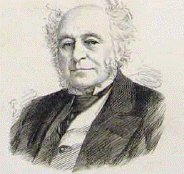 cketers had
inadvertently washed up in one of the hotspots of the industrial
age. It wasn't immediately apparent but they would soon be under
threat not only from the creeping menace from the city centre but also
from the burgeoning railway system on the opposite side. By 1845,
the club was being compressed into a smaller area and it was obvious to
all that they would soon be required to seek yet another site.
Anxiously looking on was an army of bricklayers and stonemasons who
began work as soon as the site was vacated and turned the cricket pitch
into massive warehouses with the words Fruit and Vegetable
Depot chiselled above the entrance. The Fruit and Vegetable
Depot grew in proportion to the rail system and became a sort
of Edge Hill version of Les Halles. For the next
hundred years the Depot throbbed with activity, night and day, and
having survived the best efforts of the Luftwaffe, resumed work to full
capacity after the Second World War ----but it couldn't survive the
policies of Liverpool City Council who remained true to their
traditional policy of the destruction of anything even
remotel historic and razed it to the ground in the 1990's. cketers had
inadvertently washed up in one of the hotspots of the industrial
age. It wasn't immediately apparent but they would soon be under
threat not only from the creeping menace from the city centre but also
from the burgeoning railway system on the opposite side. By 1845,
the club was being compressed into a smaller area and it was obvious to
all that they would soon be required to seek yet another site.
Anxiously looking on was an army of bricklayers and stonemasons who
began work as soon as the site was vacated and turned the cricket pitch
into massive warehouses with the words Fruit and Vegetable
Depot chiselled above the entrance. The Fruit and Vegetable
Depot grew in proportion to the rail system and became a sort
of Edge Hill version of Les Halles. For the next
hundred years the Depot throbbed with activity, night and day, and
having survived the best efforts of the Luftwaffe, resumed work to full
capacity after the Second World War ----but it couldn't survive the
policies of Liverpool City Council who remained true to their
traditional policy of the destruction of anything even
remotel historic and razed it to the ground in the 1990's.But in 1845, Liverpool Cricket Club once again found itself without somewhere to erect a wicket and were subsequently offered help from a most unlikely quarter. Sir Hardman Earle owned a vast tract of land encompassing much of Smithdown road, Picton road and Smithdown lane called the Spekelands estate which he managed from the mansion in the centre called Spekeland House. Sir Hardman Earle, whose name lives on in Earle road and Earlestown, was ironically a director of the L and N W railway and the Cricket Club bowed to the inevitable when they accepted his offer of a new playing field. Sir Hardman Earle leased the cricketers a section of his estate running parallel with the rail line on one side and backed onto by the brand new gas-works on the other and by 1847 the Liverpool Cricket Club were playing their matches within the confines of a brick wall and had the luxury of a wooden pavilion in a ground they called Spekefields. They also took advantage of the new rail line and trips to Manchester and beyond were made far easier than on previous occasions. It seemed that once again the future looked secure for the Cricket Club but some of the more astute members might have looked up from the outfield occasionally and sensed that the symbols of the new industrial age overlooking the ground were merely a foretaste of things to come. Successive maps of the Earle fiefdom throughout the Victorian era show a gradual infiltration of legions of back-to-back houses spreading outwards from the city centre in all directions. Decade after decade, street after street and house after house, inexorably annexed great parcels o F. R. Spofforth, the Australian Demon Bowler. St. Dunstan's church was built on the site of the Earle mansion, Spekelands, built in 1804. A contemporary sketch of the Mansion illustrates clearly that the house was in a woodland and farmland setting, far from the inner city warrens of houses. The mansion was demolished in 1882 surrounded by a sea of terraced houses.
|